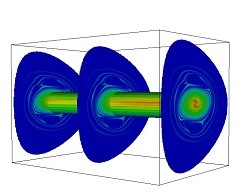Coupling models describe the kinetic processes in plasma
Particle transport in plasmas or rarefied gases can be predicted by kinetic or hydrodynamic models. The former is based, amongst others, on Boltzmann kinetic equations that can be solved using either statistical particle methods and Monte Carlo simulations or a numerical solution of the kinetic equations employing discrete velocity methods. Fluid models, which apply for particles that are at thermodynamic equilibrium, can be derived from the kinetic equations, and describe the system on a macroscopic level. Within the EU-funded HNSKMAP, scientists worked on hybrid kinetic-fluid models, combining the accuracy of kinetic solvers with the efficiency of fluid models. Deriving the best of both worlds The kinetic description is the most fundamental way to model plasmas and rarefied gases. In such models that access even the electron scale, each particle is described by a distribution function f in six dimensions. This function represents all there is to know about the plasma state: in other words, f represents the number of particles per unit volume having a given velocity at a certain time. The fluid description refers to any simplified plasma model that deals with quantities averaged over velocity space, hence, with macroscopic quantities. Fluid equations may be easier to solve but they have a limited range of applicability. “Unlike fluid models, the kinetic equation describes the thermodynamics of non-equilibrium processes, namely of particle systems whose distribution function is very different from the Maxwell-Boltzmann probability distribution,” explains Prof. Francis Filbet. As he further explains, “Compared to the fluid models, the distribution function provides more information about the particles such as their velocity distribution.” HNSKMAP’s research was geared towards the use of hybrid kinetic-fluid methods, significantly narrowing down the use of kinetic descriptions only to desired space regions. “A hybrid approach allows the modelling of complex thermo-fluid phenomena at the micro scale, circumventing the use of kinetic calculations that are computationally demanding, and have therefore a prohibitive cost,” explains Prof. Filbet. The newly developed hybrid method has simple indicators that allow determination of a coupling space region where the kinetic and macroscopic models are connected. “The selection of the coupling space region is key to the development of a robust hybrid method,” notes Prof. Filbet. Thanks to the coupling techniques of the computational algorithms for solving the kinetic equations with the macroscopic numerical methods for the Euler (fluid) equations, the proposed hybrid scheme degenerates to a finite set of quantities at discrete points spaced into a so-called grid or mesh. To characterise the space region with a finite set of functions, scientists developed a proper discontinuous Galerkin method that ultimately aided the analysis of continuous models and their hydrodynamic limits. “Our research concentrated on developing numerical analysis methods using a phase-space grid as opposed to particle methods. Rigorous mathematical analysis is essential to optimise the number of mesh points and develop efficient algorithms,” notes Prof. Filbet. Another project highlight was the design of an asymptotic model for studying how Kelvin‐Helmholtz instabilities generate vortices that propagate along magnetised plasma. Numerical simulations illustrated how an initial current perturbation causes these instabilities. HNSKMAP focused on the fundamental computational challenges that arise when simulating plasmas of high-energy density or rarefied gas dynamics. Suitable for high-performance computing, the newly developed numerical methods help model differential equations that scale with the size of particle systems.
Keywords
HNSKMAP, fluid, plasma, hydrodynamics, kinetic theory, thermodynamic equilibrium, hybrid kinetic-fluid models



